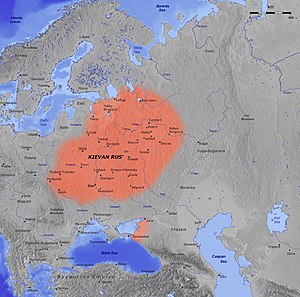This is an old revision of this page, as edited by Iryna Harpy (talk | contribs) at 22:25, 9 September 2013 (→History: Instating appropriate wikilinks). The present address (URL) is a permanent link to this revision, which may differ significantly from the current revision.
Revision as of 22:25, 9 September 2013 by Iryna Harpy (talk | contribs) (→History: Instating appropriate wikilinks)(diff) ← Previous revision | Latest revision (diff) | Newer revision → (diff)| It has been suggested that this article be merged into Ruthenia. (Discuss) Proposed since July 2013. |
| This article does not cite any sources. Please help improve this article by adding citations to reliable sources. Unsourced material may be challenged and removed. Find sources: "Rus'" region – news · newspapers · books · scholar · JSTOR (November 2008) (Learn how and when to remove this message) |

Rus' (Old East Slavic русьскаꙗ землꙗ "land of the Rusĭ (Русь)") is an ethno-cultural region in Eastern Europe inhabited by Eastern Slavs. Historically, it comprises the northern part of Ukraine, the north-western part of Russia, Belarus and some neighbouring parts of Finland, the Baltic states, Poland and Slovakia.
The name comes from Old East Slavic Error: {{Lang}}: text has italic markup (help), and remains the same in modern Belarusian, Russian and Ukrainian. In Greek it is called Error: {{Lang}}: text has italic markup (help) or Error: {{Lang}}: text has italic markup (help), in Armenian Error: {{Lang}}: text has italic markup (help), and in Latin Error: {{Lang}}: text has italic markup (help) or Error: {{Lang}}: text has italic markup (help). For more about the etymology, see Rus (name).
Name
Main article: Rus (name)History
Main articles: Rus Khaganate, Kievan Rus, Novgorod Republic, Vladimir-Suzdal, Kingdom of Rus, and Tsardom of RussiaThe Kievan Rus had its cultural and political height in the 10th and 11th century and later disintegrated into many small principalities. The most powerful successor states were Vladimir-Suzdal, Halych-Volhynia and Novgorod Republic.
The Mongol invasion of Rus' devastated the north-eastern parts in 1237–1238 and the south western parts of Rus in 1239–1240. From this date on, the fate of the Rus lands began to diverge: The north-eastern parts stayed under the rule of Mongols and the Golden Horde for two more centuries, while the western parts, together with Kiev, joined the pagan Balts (Samogitians, today known as "Lithuanians") to form a strong resistance to the Tartars to the East and to the Teutonic Order to the West.
Thus, the Grand Duchy of Lithuania was born. Eventually, the Grand Duke Yogayla (Pol. Jagiello) converted to Catholicism, married the Polish Princess Jadwiga (Hedviga) and became King of Poland. This political development caused a certain cultural and linguistic split between Eastern Slavs which previously almost didn't exist. However, the Orthodox church, which resided in Vladimir and later in Moscow, remained a common unifying factor within the Rus lands.
In the Grand Duchy of Lithuania, which had an Eastern Slavic majority of the population, as well as the official Slavic language (the precursor of modern Belarusian), the Lithuanian gentry converted to (the Grand Duke's) Catholicism. A compromise was proposed by the Vatican, so that the Orthodox Christians would maintain their rituals, language, and clergy - but recognize the Pope as their pontiff. The Greek Orthodox Church was thus formed (1599).
A majority of the Orthodox Slavs accepted the Greek Catholic (aka Uniate) church. A rivalry between the Grand Duchies of Moscow and Lithuania, both of whom considered themselves as the centre of the Rus, and legitimate successors of Kiev (Ivan III called himself the Grand Duke of all the Rus) caused several wars, and showed Muscovite predominance by the beginning of the 16th century. By 1569 (The Lublin Union), Poland emerged as the dominant part of the Union, and the Southern part of the Duchy were ruled directly from Warsaw, becoming known as the Polish Rus' (present day Ukraine). The Polish-Lithuanian Commonwealth weakened, whilst the Muscovite Duchy's power increased.
By 1650, Eastern Ukraine was made part of Muscovy. In the early 1700s, Peter the 1st renamed Muscovy to "The Empire of Russia", a name that previously had encompassed all the Eastern Slavs. The South-Eastern Slavs were then called the "Lesser Rus", while the North-Western Slavs: Byelarus (White Ruthenians). Finally, the Empress Catherine (1785-1794) conquered most of the former Polish-Lithuanian Commonwealth, while parts of Western Poland went to Prussia, and Southern Poland and Ukrainian Halych went to Austria.
The Ukrainian minority in Slovakia today still call themselves "Rusyny" (Ruthenians), i.e. derived from Rus'. Modern Belarusian and modern Ukrainian are very closely related, while they differ from modern Russian.
Notes
See also
- Rus' people
- Rus (name)
- White Rus
- Black Rus
- Red Rus
- Kievan Rus
- Ruthenia
- Ruthenian Voivodship
- Principality of Ruthenia